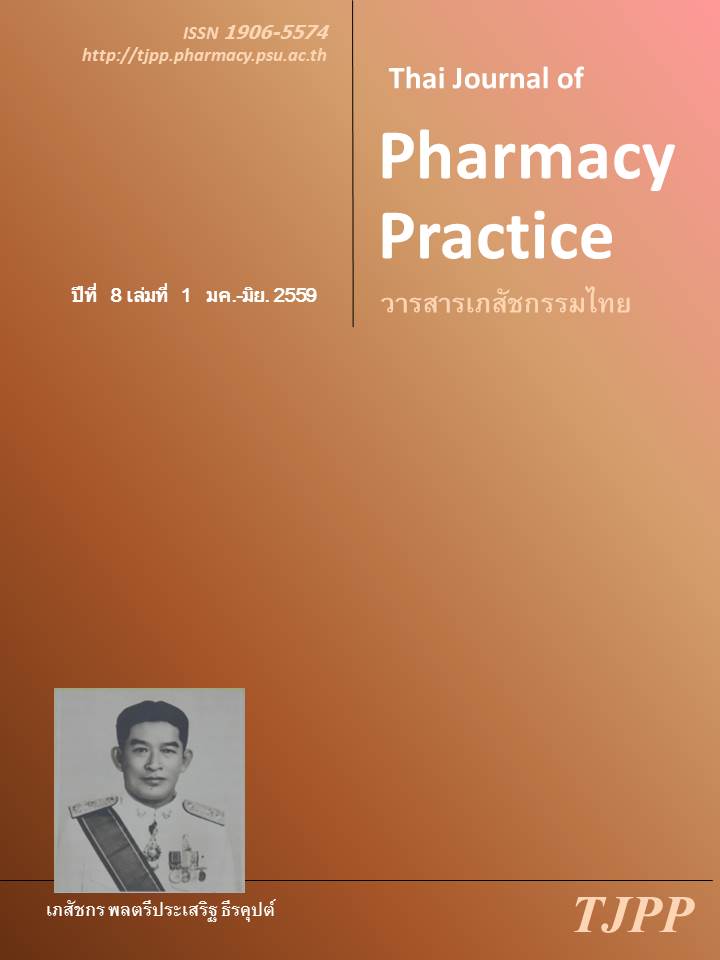รายการยาที่ไม่เหมาะสมที่ผู้สูงอายุใช้ในบ้านพักคนชรา
Main Article Content
บทคัดย่อ
วัตถุประสงค์: เพื่อศึกษาการใช้ยาของผู้สูงอายุและรายการยาที่ไม่เหมาะสมต่อผู้สูงอายุในบ้านพักคนชรา วิธีการ: การวิจัยนี้เป็นการศึกษาเชิงพรรณนาภาคตัดขวางที่รวบรวมข้อมูลรายการยาจากทะเบียนสุขภาพ การสอบถาม และพิจารณาดูรายการยาที่กำลังใช้จริงของผู้สูงอายุที่มีอายุ ≥ 60 ปี และกำลังได้รับยาอย่างน้อย 1 รายการ ในศูนย์พัฒนาการจัดสวัสดิการสังคมผู้สูงอายุบ้านบางแค กรุงเทพมหานคร ผู้วิจัยประเมินรายการยาที่ไม่เหมาะสมต่อผู้สูงอายุโดยใช้เกณฑ์ 2012 AGS Beers criteria ผลการศึกษา: กลุ่มตัวอย่าง 105 ราย เป็นเพศหญิงร้อยละ 75.2 อายุเฉลี่ย 79.1 ± 7.7 ปี โรคที่พบ 3 ลำดับแรก คือ โรคความดันโลหิตสูง (ร้อยละ 60.0) โรคกระดูกและข้อ (ร้อยละ 41.0) และไขมันในเลือดสูง (ร้อยละ 40.0) ผู้สูงอายุประมาณร้อยละ 86 ได้รับยา ≥ 5 รายการ (polypharmacy) กลุ่มยาที่มีการใช้ 3 ลำดับแรก คือ ยาระบบหัวใจและหลอดเลือด (ร้อยละ 23.8) วิตามินและเกลือแร่ (ร้อยละ 20.1) และยาที่ออกฤทธิ์ต่อระบบประสาทส่วนกลาง (ร้อยละ 14.5) ผู้สูงอายุร้อยละ 61.0 ได้รับรายการยาไม่เหมาะสม รายการยาที่ไม่เหมาะสม 3 ลำดับแรก คือ chlorpheniramine (ร้อยละ 17.4) orphenadrine (ร้อยละ 15.9) และ lorazepam (ร้อยละ 14.5) จำนวนรายการยามีความสัมพันธ์กับการได้รับรายการยาที่ไม่เหมาะสมอย่างมีนัยสำคัญทางสถิติ (p<0.01) เมื่อวิเคราะห์โดยสถิติ binary logistic regression พบว่า การได้รับยา ≥ 11 รายการ เพิ่มโอกาสในการได้รับรายการยาที่ไม่เหมาะสม 11.34 เท่าตัว (95% CI=1.97-65.33) เมื่อเทียบกับการได้รับยา 0-4 รายการ ส่วนเพศ ช่วงอายุ ระดับการศึกษา จำนวนโรค/อาการ และจำนวนแหล่งรับยา ไม่มีความสัมพันธ์กับการได้รับรายการยาที่ไม่เหมาะสม สรุป: ผู้สูงอายุในบ้านพักคนชรามีโรค/อาการพร้อมกันหลายโรค นำไปสู่การใช้ยาหลายรายการ และทำให้เกิดความเสี่ยงต่อการได้รับรายการยาที่ไม่เหมาะสม ข้อมูลจากงานวิจัยอาจช่วยเพิ่มความปลอดภัยในการใช้ยาของผู้สูงอายุในบ้านพักคนชราต่อไป
Article Details
ผลการวิจัยและความคิดเห็นที่ปรากฏในบทความถือเป็นความคิดเห็นและอยู่ในความรับผิดชอบของผู้นิพนธ์ มิใช่ความเห็นหรือความรับผิดชอบของกองบรรณาธิการ หรือคณะเภสัชศาสตร์ มหาวิทยาลัยสงขลานครินทร์ ทั้งนี้ไม่รวมความผิดพลาดอันเกิดจากการพิมพ์ บทความที่ได้รับการเผยแพร่โดยวารสารเภสัชกรรมไทยถือเป็นสิทธิ์ของวารสารฯ
เอกสารอ้างอิง
2. Duangthipsirikul S, Sirisamut T, Tantipisitkul K, Tirawattananon Y, Ingsrisawang L. Preliminary study report: Health surveys of Thai older adults 2013 [online]. 2014 [cited 2015 Mar 9]. Available from: URL: https://www.hitap.net/documents/24067.
3. Chen YC, Fan JS, Chen MH, Hsu TF, Huang HH, Cheng KW, et al. Risk factors associated with adverse drug events among older adults in emergency department. Eur J Intern Med. 2014;25:49-55.
4. Pan HH, Li CY, Chen TJ, Su TP, Wang KY. Association of polypharmacy with fall-related fractures in older Taiwanese people: age-and gender-specific analyses. BMJ Open 2014; 28;4:e004428. doi: 10.1136/bmjopen-2013-004428.
5. Budnitz DS, Lovegrove MC, Shehab N, Richards CL. Emergency hospitalizations for adverse drug events in older Americans. N Engl J Med. 2011; 365: 2002-12.
6. Nash DB, Koenig JB, Chatterton ML. Why the elderly need individualized pharmaceutical care. Philadelphia: Thomas Jefferson University; 2000.
7. American Geriatrics Society 2012 Beers Criteria Update Expert Panel. American Geriatrics Society updated Beers Criteria for potentially inappropriate medication use in older adults. J Am Geriatr Soc 2012; 60: 616–31.
8. Shah SM, Carey IM, Harris T, DeWilde S, Cook DG. Quality of prescribing in care homes and the community in England and Wales. Br J Gen Pract. 2012; 62: e329-e36.
9. Cool C, Cestac P, Laborde C, Lebaudy C, Rouch L, Lepage B, et al. Potentially inappropriate drug prescribing and associated factors in nursing homes. J Am Med Dir Assoc. 2014;15:850. e1-. e9.
10. Chaimay B. Sample size determination in descriptive study in public health. Thaksin University Journal 2013; 16: 9-18.
11. Ruggiero C, Dell’Aquila G, Gasperini B, Onder G, Lattanzio F, Volpato S, et al. Potentially inappropriate drug prescriptions and risk of hospitalization among older, Italian, nursing home residents. Drug & Aging. 2010; 27: 747-58.
12. Chen LL, Tangiisuran B, Shafie AA, Hassali MAA. Evaluation of potentially inappropriate medications among older residents of Malaysian nursing homes. Int J Clin Pharm. 2012; 34: 596-603.
13. Ploylearmsang C, Kerdchantuk O, SoonKlang K, Worasin P, kedchareon P. Drug-related problems and factors affecting on drug use problems in elderly of Banmakok, Kantharawichai, Maha Sarakham province. In: Therdkul P, editor. Proceeding of the 9th Mahasarakharm university research conference; 2013 Sep 12-13; Mahasarakharm, Thailand. Mahasarakharm: Mahasarakharm University; 2013. p. 803-12.
14. Diabetes Association of Thailand, The Endocrine Society of Thailand, Department of Medical Services, Office NHS. Clinical practice guideline for diabetes 2014. Bangkok: Aroonkarnpim; 2014.
15. Blanco‐Reina E, Ariza‐Zafra G, Ocaña‐Riola R, and León‐Ortiz M. 2012 American Geriatrics Society Beers Criteria: enhanced applicability for detecting potentially inappropriate medications in European older adults? A comparison with the screening tool of older person's potentially inappropriate prescriptions. J Am Ger Soc. 2014; 62: 1217-23.
16. Ma H, Lum C, Dai L, Kwok C. Potentially inappropriate medication in elderly patients in outpatient clinics. Asian J Gerontol Geriatr. 2008; 3: 27-33.
17. Alhmoud E, Khalifa S, Bahi AA. Prevalence and predictors of potentially inappropriate medications among home care elderly patients in Qatar. Int J Clin Pharm. 2015;37:815-21.


